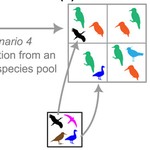Abstract
Temporal biodiversity change involves colonization, extinction, and recurrence of species. These processes vary with spatial grain (i.e. the area at which biodiversity is assessed), but there is little theory to explain this. Here, we present theoretical scenarios showing that colonization, extinction, and recurrence of species can either increase or decrease in strength across grain size.
We tested for these patterns in empirical data on Czech birds over 30 years, and several orders of magnitude of spatial grain.
We found that colonization increased from local to national scales, while extinctions followed a hump-shaped pattern, leading to a higher temporal increase of richness towards coarse grains. Probabilities of colonization and extinction decreased with grain size, with a steeper decrease for extinction. Our results hold independently across two time periods (1985–2002 and 2002–2017), and colonization is the dominant process behind temporal change of richness.
This decomposition of biodiversity change allowed us to identify scale-wise ecological mechanisms driving biodiversity change, and explain seemingly confusing directions of biodiversity change at different spatial scales.
